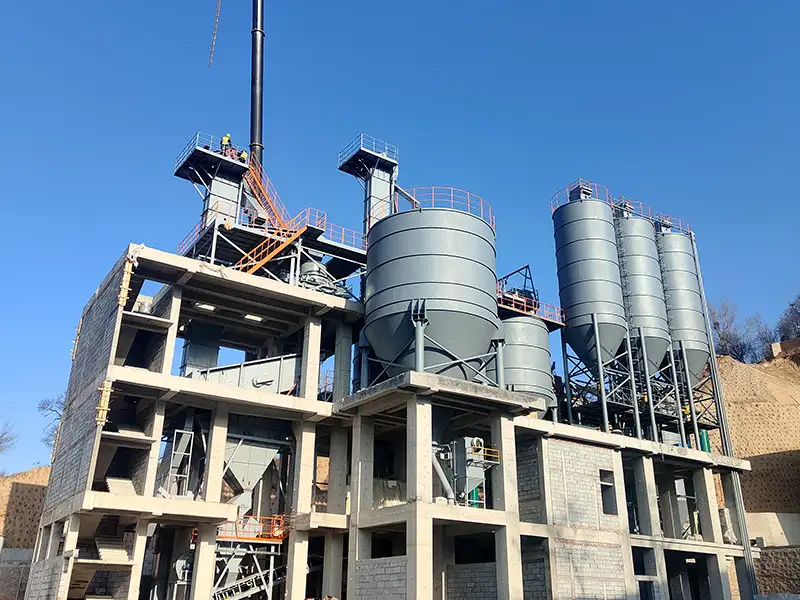Dry Mortar Production Line: The Core of Efficient and Environmentally Friendly Building Material Manufacturing
As an important material in the modern construction industry, dry-mix mortar production lines achieve full-process automated control from raw materials to finished products through scientific process design and advanced equipment. The following is a detailed analysis of its core production processes and key technologies.
Aug 01,2025

As an important material in the modern construction industry, dry-mix mortar production lines achieve full-process automated control from raw materials to finished products through scientific process design and advanced equipment. The following is a detailed analysis of its core production processes and key technologies.
Raw Material Pretreatment: Laying the Foundation for Quality
The first step in producing dry-mix mortar is raw material pretreatment, with a focus on drying and screening sand and gravel aggregates. Taking river sand as an example, which typically has a moisture content of up to 7%, it needs to be processed using a double-return drying drum: the inner drum uses a high-temperature heat source to dry the sand to a moisture content of ≤0.5%, while the outer layer introduces natural cold air for counter-current cooling, ensuring the discharge temperature is controlled below 65°C to avoid damaging the performance of admixtures (e.g., cellulose ether deactivates at high temperatures). The screening process uses a single vibrating screen to remove particles larger than 5mm, and then a probability screen to classify the sand into four particle size ranges, such as 0-0.6mm and 0.6-1.18mm, to meet the requirements of different mortar formulations. Manufactured sand, with its low moisture content, can directly enter the screening process, simplifying the workflow.
Intelligent Metering and Precise Batching
Pretreated raw materials (cement, sand, additives, etc.) are stored in closed silos respectively, and precise batching is achieved through a central control system. For bulk materials (such as cement), screw conveyors are used in conjunction with loss-in-weight scales for dynamic metering; for small materials (such as rubber powder), electronic scales are used for accurate weighing, with errors controlled within ±0.3%. The system can automatically adjust the proportion of each raw material according to the formula. For example, in masonry mortar, sand accounts for approximately 70%, cement 20%, and additives 10%. The metered materials are transported to the mixing silo through closed pipelines to avoid dust spillage.
Efficient Mixing and Uniform Stirring
The mixing process is crucial for ensuring mortar performance, and the twin-shaft gravity-free mixer plays a core role here. The twin shafts inside the equipment rotate in opposite directions at a specific angle, and the blades throw the materials into the space to form a fluidized weightlessness zone, achieving uniform mixing in three-dimensional composite movement. It only takes 2-3 minutes to reach a uniformity of over 99%. A spray device can be installed on the top of the mixer to realize solid-liquid mixing (liquid content <15%), meeting the production needs of special mortars.
Intelligent Packaging and Finished Product Management
After being buffered in the finished product silo, the mixed mortar enters the packaging system. The valve bag packaging machine adopts screw feeding + air-assisted technology: in the initial stage, it fills at high speed to 70% of the weight, and in the later stage, it achieves precise refilling through frequency conversion speed regulation and air pressure adjustment, with an error of <±0.5%. The packaging port is integrated with a dust collection hood, ensuring that dust emissions meet environmental protection standards. Bulk mortar is transported by closed tank trucks to avoid segregation. Finished products need to be stored in separate areas: bagged products are placed in a dry and ventilated environment, and bulk silos are equipped with arch-breaking devices to prevent caking.
Environmental Protection and Sustainable Design
The production line adopts a closed system throughout and is equipped with multi-stage dust removal equipment. For example, membrane bag filters are installed on the top of the mixing host and silos, with dust emission concentration <10mg/m³, which is better than the national standard. Wastewater is recycled after treatment in a three-stage sedimentation tank, and aggregate is recovered and reused by a sand-stone separator. In terms of noise control, low-noise equipment is selected, and measures such as foundation shock absorption and sound insulation covers are adopted to ensure that the factory boundary noise meets the standard.
Intelligent Upgrading and Future Trends
Modern production lines are developing towards intelligence and low carbonization. For example, continuous production lines can achieve a capacity of 80-200 tons per hour through dynamic metering and three-stage mixing, with power consumption per ton <0.5 kWh. The application of IoT technology can real-time monitor equipment status, raw material inventory, and energy consumption data, automatically alarm for faults, and prompt solutions.
In the future, with the advancement of building industrialization, dry-mix mortar production lines will further integrate green building material technologies, such as the utilization of recycled aggregates and carbon dioxide mineralization curing, to promote the sustainable development of the industry.
Through the above processes, the dry-mix mortar production line, with its characteristics of high efficiency, environmental protection, and intelligence, provides the construction industry with high-quality materials with stable quality and convenient construction, becoming an important support for promoting the development of green buildings.
PREVIOUS:

